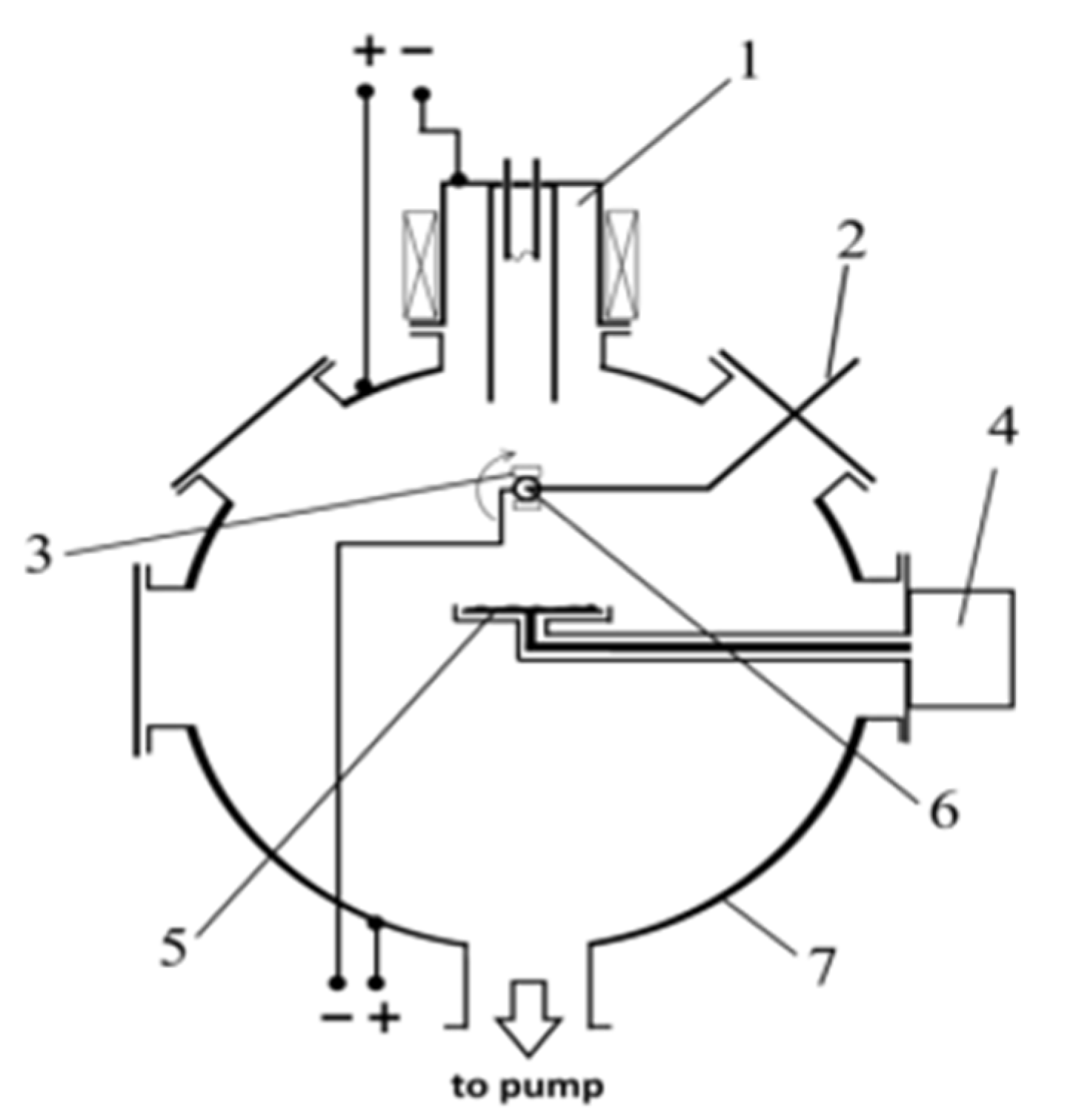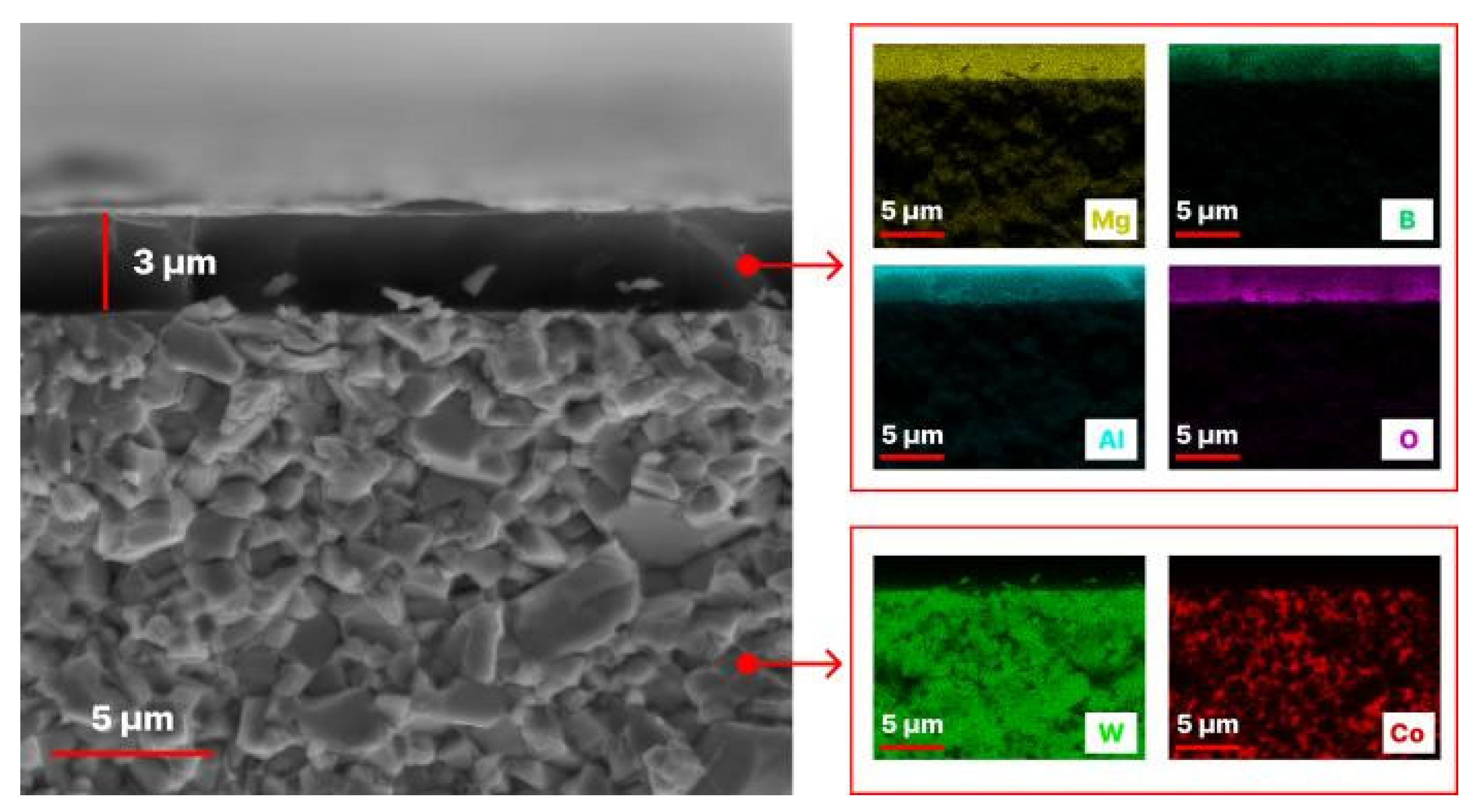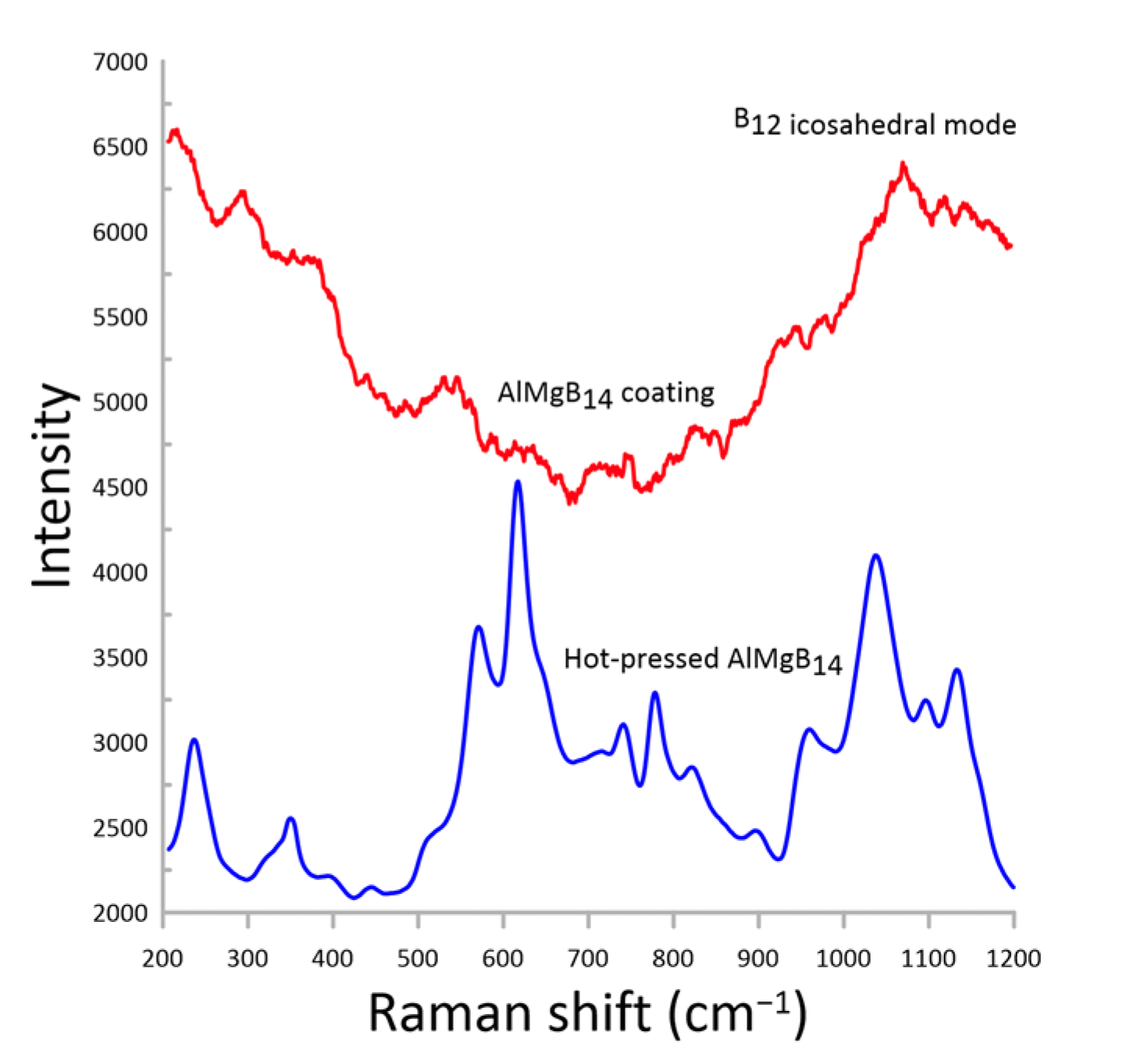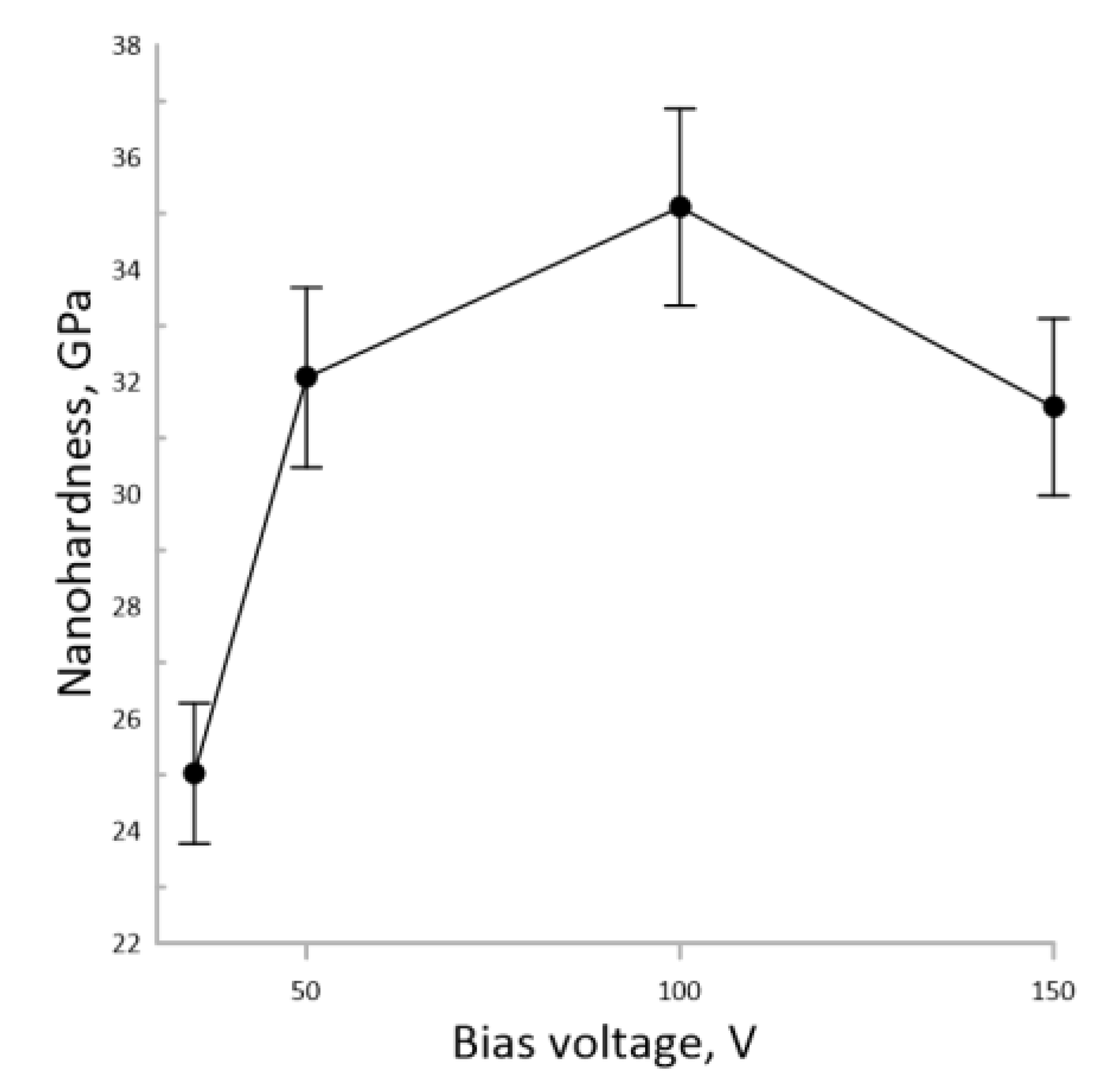Structure and Frictional Properties of Ultrahard AlMgB14 Thin Coatings
Abstract
:1. Introduction
2. Materials and Methods
2.1. Process for Obtaining AlMgB14-Based Ceramic Powders
2.2. RF Plasma Sputtering
2.3. Characterization
3. Results
3.1. Microstructure
3.2. Composition and Crystal Structure
3.3. Mechanical and Tribological Properties
4. Discussion
5. Conclusions
Author Contributions
Funding
Data Availability Statement
Acknowledgments
Conflicts of Interest
References
- Cook, B.A.; Harringa, J.L.; Lewis, T.L.; Russell, A.M. A New Class of Ultra-Hard Materials Based on AlMgB14. Scr. Mater. 2000, 42, 597–602. [Google Scholar] [CrossRef] [Green Version]
- Gotman, I.; Gutmanas, E.Y. Titanium Nitride-Based Coatings on Implantable Medical Devices. Adv. Biomater. Devices Med. 2014, 1, 53–73. [Google Scholar]
- Ruggiero, P.F. Tungsten Carbide Coatings Replace Chromium. Available online: http://www.wococarbide.com/Uploads/2017-07-31/597edb1697a16.pdf (accessed on 24 October 2022).
- Cremer, R.; Reichert, K.; Neuschütz, D.; Erkens, G.; Leyendecker, T. Sputter Deposition of Crystalline Alumina Coatings. Surf. Coat. Technol. 2003, 163–164, 157–163. [Google Scholar] [CrossRef]
- Mikula, M.; Grančič, B.; Buršíková, V.; Csuba, A.; Držík, M.; Kavecký, Š.; Plecenik, A.; Kúš, P. Mechanical Properties of Superhard TiB2 Coatings Prepared by DC Magnetron Sputtering. Vacuum 2007, 82, 278–281. [Google Scholar] [CrossRef]
- Sumant, A.V.; Krauss, A.R.; Gruen, D.M.; Auciello, O.; Erdemir, A.; Williams, M.; Artiles, A.F.; Adams, W. Ultrananocrystalline Diamond Film as a Wear-Resistant and Protective Coating for Mechanical Seal Applications. Tribol. Trans. 2005, 48, 24–31. [Google Scholar] [CrossRef]
- Cherukuri, R.; Womack, M.; Molian, P.; Russell, A.; Tian, Y. Pulsed Laser Deposition of AlMgB14 on Carbide Inserts for Metal Cutting. Surf. Coat. Technol. 2002, 155, 112–120. [Google Scholar] [CrossRef]
- Cook, B.A.; Harringa, J.L.; Anderegg, J.; Russell, A.M.; Qu, J.; Blau, P.J.; Higdon, C.; Elmoursi, A.A. Analysis of Wear Mechanisms in Low-Friction AlMgB14–TiB2 Coatings. Surf. Coat. Technol. 2010, 205, 2296–2301. [Google Scholar] [CrossRef]
- Higdon, C.B.; Cook, B.; Harringa, J.; Russell, A.; Goldsmith, J.; Qu, J.; Blau, P. Friction and Wear Mechanisms in AlMgB14-TiB2 Nanocoatings. Wear 2011, 271, 2111–2115. [Google Scholar] [CrossRef]
- Nikitin, P.Y.; Zhukov, I.A.; Matveev, A.E.; Sokolov, S.D.; Boldin, M.S.; Vorozhtsov, A.B. AlMgB14–TiB2 Composite Materials Obtained by Self-Propagating High-Temperature Synthesis and Spark Plasma Sintering. Ceram. Int. 2020, 46, 22733–22737. [Google Scholar] [CrossRef]
- Zhukov, I.A.; Nikitin, P.Y.; Vorozhtsov, A.B.; Perevislov, S.N.; Sokolov, S.D.; Ziatdinov, M.H. The Use of Intermetallic AlxMgy Powder to Obtain AlMgB14-Based Materials. Mater. Today Commun. 2020, 22, 100848. [Google Scholar] [CrossRef]
- Kevorkijan, V.; Škapin, S.D.; Jelen, M.; Krnel, K.; Meden, A. Cost-Effective Synthesis of AlMgB14–XTiB2. J. Eur. Ceram. Soc. 2007, 27, 493–497. [Google Scholar] [CrossRef]
- Ivashchenko, V.I.; Scrynskyy, P.L.; Dub, S.N.; Butenko, O.O.; Kozak, A.O.; Sinelnichenko, O.K. Structural and Mechanical Properties of Al―Mg―B Films: Experimental Study and First-Principles Calculations. Thin Solid Films 2016, 599, 72–77. [Google Scholar] [CrossRef]
- Grishin, A.M.; Khartsev, S.I.; Böhlmark, J.; Ahlgren, M. Ultra-Hard AlMgB14 Coatings Fabricated by RF Magnetron Sputtering from a Stoichiometric Target. JETP Lett. 2015, 100, 680–687. [Google Scholar] [CrossRef]
- Noroozi, M.; Petruhins, A.; Greczynski, G.; Rosen, J.; Eklund, P. Structural and Mechanical Properties of Amorphous AlMgB14 Thin Films Deposited by DC Magnetron Sputtering on Si, Al2O3 and MgO Substrates. Appl. Phys. A Mater. Sci. Process. 2020, 126, 133. [Google Scholar] [CrossRef] [Green Version]
- Yan, C.; Qian, J.C.; Ng, T.W.; Zhou, Z.F.; Li, K.Y.; Zhang, W.J.; Bello, I.; Martinu, L.; Klemberg-Sapieha, J.E. Sputter Deposition of Hard Quaternary Al–Mg–B–Ti Nanocomposite Films. Surf. Coat. Technol. 2013, 232, 535–540. [Google Scholar] [CrossRef]
- Nikitin, P.Y.; Matveev, A.E.; Zhukov, I.A. Energy-Effective AlMgB14 Production by Self-Propagating High-Temperature Synthesis (SHS) Using the Chemical Furnace as a Source of Heat Energy. Ceram. Int. 2021, 47, 21698–21704. [Google Scholar] [CrossRef]
- Shugurov, V.V.; Akhmadeev, Y.H.; Zhukov, I.A.; Yu Nikitin, P. Deposition of AlMgB14 Films by Sputtering in a Non-Self-Sustained High-Frequency Discharge. J. Phys. Conf. Ser. 2021, 1954, 012042. [Google Scholar] [CrossRef]
- Oliver, W.C.; Pharr, G.M. An Improved Technique for Determining Hardness and Elastic Modulus Using Load and Displacement Sensing Indentation Experiments. J. Mater. Res. 1992, 7, 1564–1583. [Google Scholar] [CrossRef]
- Tkachev, D.; Nikitin, P.; Zhukov, I.; Vorozhtsov, A.; Marchenko, E.; Verkhoshanskiy, Y.; Belchikov, I. Structure and Flexural Strength of the Hot-Pressed AlMgB14 Ceramic. Phys. Scr. 2023, 98, 025703. [Google Scholar] [CrossRef]
- Grishin, A.M. Hardness, Young’s Modulus and Elastic Recovery in Magnetron Sputtered Amorphous AlMgB14 Films. Crystals 2020, 10, 823. [Google Scholar] [CrossRef]
- Hui, Z.; Li, Z.; Ju, P.; Yingjian, N.; Ouyang, J.; Tian, Y. Comparative Studies of the Tribological Behaviors and Tribo-Chemical Mechanisms for AlMgB14-TiB2 Coatings and B4C Coatings Lubricated with Molybdenum Dialkyl-Dithiocarbamate. Tribol. Int. 2019, 138, 47–58. [Google Scholar] [CrossRef]
- Werheit, H.; Filipov, V.; Kuhlmann, U.; Schwarz, U.; Armbrüster, M.; Leithe-Jasper, A.; Tanaka, T.; Higashi, I.; Lundström, T.; Gurin, V.N.; et al. Raman Effect in Icosahedral Boron-Rich Solids. Sci. Technol. Adv. Mater. 2010, 11, 023001. [Google Scholar] [CrossRef] [PubMed] [Green Version]
- Tian, Y.; Bastawros, A.F.; Lo, C.C.H.; Constant, A.P.; Russell, A.M.; Cook, B.A. Superhard Self-Lubricating AlMgB14 Films for Microelectromechanical Devices. Appl. Phys. Lett. 2003, 83, 2781–2783. [Google Scholar] [CrossRef] [Green Version]
- Chen, J.; Cheng, J.; Li, F.; Zhu, S.; Li, W.; Yang, J.; Liu, W. Tribological Study on a Novel Wear-Resistant AlMgB14-Si Composite. Ceram. Int. 2017, 43, 12362–12371. [Google Scholar] [CrossRef]
- Nikitin, P.; Zhukov, I.; Tkachev, D.; Abzaev, Y.; Marchenko, E.; Vorozhtsov, A. Experimental and Theoretical Study of Ultra-Hard AlMgB14-TiB2 Composites: Structure, Hardness and Self-Lubricity. Materials 2022, 15, 8450. [Google Scholar] [CrossRef]
- Lu, X.; Yao, K.; Ouyang, J.; Tian, Y. Tribological Characteristics and Tribo-Chemical Mechanisms of Al–Mg–Ti–B Coatings under Water–Glycol Lubrication. Wear 2015, 326–327, 68–73. [Google Scholar] [CrossRef]
- Qu, J.; Blau, P.J.; Zhu, D.; Cook, B.A.; Elmoursi, A.A. Tribological Characteristics of AlMgB14 and Nanocomposite AlMgB14-TiB2 Superhard Coatings. In Proceedings of the STLE/ASME 2008 International Joint Tribology Conference, Miami, FL, USA, 20–22 October 2008. [Google Scholar]
- Qu, W.; Wu, A.; Wu, Z.; Bai, Y.; Jiang, X. Influence of Boron Contents on Properties of AlMgB Films Prepared by RF Magnetron Sputtering. Rare Metals 2012, 31, 164–167. [Google Scholar] [CrossRef]









| Parameter | Cleaning and Heating | Sputtering |
|---|---|---|
| Plasma generator current, A | 15 | 50 |
| Ar pressure, Pa | 0.5 | 0.5 |
| Bias voltage, V | 990 | 30/50/100/150 |
| RF-generator power, W | - | 700 |
| Time, min | 15 | 180 |
| Composition | Method of Obtaining | Conditions of the Tribological Properties Determination | Hardness, GPa | COF | Wear Rate, mm3/N·m | References |
|---|---|---|---|---|---|---|
| AlMgB14 | RF plasma sputtering | Ball material: 100Cr6 Environment: dry Load: 1 N Speed: 25 mm/s | 37 ± 2 | 0.12 | 7.5 × 10−5 | This work |
| AlMgB14-30 wt. % Si | Spark plasma sintering | Ball material: 316 L Environment: dry Load: 60 N Speed: 60 mm/s | 27.45 ± 2.15 | 0.19–0.28 | 8 × 10−6 | [25] |
| AlMgB14-30 wt. % Si | Spark plasma sintering | Ball material: Si3N4 Environment: dry Load: 60 N Speed: 60 mm/s | 27.45 ± 2.15 | 0.35–0.46 | 3.8–9 × 10−5 | [25] |
| AlMgB14-50 wt. % TiB2 | Magnetron sputtering | Ball material: 52,100 Steel Environment: hydraulic oil Load: 10 N Speed: 500 mm/s | 17.8 | 0.08 | - | [8] |
| AlMgB14 | Pulsed laser deposition | Ball material: 52,100 Steel Environment: dry Load: 1 N Speed: 20 mm/s | - | 0.2 | - | [28] |
| AlMgB14-50 wt. % TiB2 | Physical vapor deposition | Ball material: 52,100 Steel Environment: dry Load: 10 N Speed: 500 mm/s | - | 0.6 | 6.5 × 10−7 | [28] |
| Al-Mg-B powder stoichiometric composition of elements | Magnetron sputtering | Ball material: Si3N4 Environment: dry Load: 3 N Speed: 1 mm/s | 30 | 0.2–0.4 | - | [29] |
| Al-Mg-B-Ti-B powder stoichiometric composition of elements | Magnetron sputtering | Ball material: 100Cr6 Environment: water-glycol Load: 1–2 N Speed: 300 mm/s | - | 0.02–0.05 | - | [27] |
Disclaimer/Publisher’s Note: The statements, opinions and data contained in all publications are solely those of the individual author(s) and contributor(s) and not of MDPI and/or the editor(s). MDPI and/or the editor(s) disclaim responsibility for any injury to people or property resulting from any ideas, methods, instructions or products referred to in the content. |
© 2023 by the authors. Licensee MDPI, Basel, Switzerland. This article is an open access article distributed under the terms and conditions of the Creative Commons Attribution (CC BY) license (https://creativecommons.org/licenses/by/4.0/).
Share and Cite
Tkachev, D.; Zhukov, I.; Nikitin, P.; Sachkov, V.; Vorozhtsov, A. Structure and Frictional Properties of Ultrahard AlMgB14 Thin Coatings. Nanomaterials 2023, 13, 1589. https://doi.org/10.3390/nano13101589
Tkachev D, Zhukov I, Nikitin P, Sachkov V, Vorozhtsov A. Structure and Frictional Properties of Ultrahard AlMgB14 Thin Coatings. Nanomaterials. 2023; 13(10):1589. https://doi.org/10.3390/nano13101589
Chicago/Turabian StyleTkachev, Dmitrii, Ilya Zhukov, Pavel Nikitin, Victor Sachkov, and Alexander Vorozhtsov. 2023. "Structure and Frictional Properties of Ultrahard AlMgB14 Thin Coatings" Nanomaterials 13, no. 10: 1589. https://doi.org/10.3390/nano13101589





